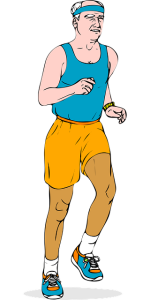-
Welcome!
In pampy's post Sept25a;
🍎 “Shake off winter and kickstart a healthier you this spring in just 14 days”
🍎 Perhaps a multi-sport event might interest you
🍎 Scientists show we age in THREE big jumps! Here are the ages and a counter punch
🍎 Here's FOUR varying ways to increase your training intensity safely
🍎 Check out my SIX favourite core exercises

-
Shake Off Winter — Spring into Action!
If you’ve powered through winter and kept up your training and clean eating — hats off to you! But if you’re like most Aussies, and the doona has won a few too many battles, then this message is for you.
After months of dreary skies, heavy rain on the East Coast, and maybe one too many comfort meals, Spring is finally here. And with it, the perfect chance to break out of cabin fever and recharge your health, energy, and fitness.
Why winter slows us down:
☀️ Less vitamin D → less motivation
🍿 More screen time → more junk food temptation
💤 Cold mornings → exercise on snooze
But here’s the good news — your body is ready to bounce back! With longer days, warmer weather, and a fresh range of produce in season, there’s no better time to reset and feel alive again.
Here’s My Invitation
I’ve created a "14-Day Spring Kickstarter Program"
🥗 A complete 7-day (repeatable) nutritional plan (with vegetarian options) — easy, flexible, Aussie meals that take the guesswork out of eating well.
🤸 Simple guidelines for stamina, strength, and stretching — repeatable, flexible, and safe.
Practical guidelines YOU can tailor to your own lifestyle.
..................................................................................................
Here’s the key bit - and trust me — grab a mate, your partner, a family member,
or even me to join you, and your chances of sticking with it go through the roof.
..................................................................................................
This Spring, let’s shake off winter together and welcome our brighter months.
-
Perhaps a multi-sport may interest you!
A multi-sport event, as you might guess, involves more than one activity within the same event. The most common example is a triathlon, which typically consists of a swim, followed by a bike ride, and finishing with a run. There are also events that include paddling, skiing, and shooting.

Personally, after spending my development years playing a lot of cricket and rugby, I took up running. Admittedly, my slightly warped personality made the idea of running long distances appealing. Additionally, my competitive nature led me to focus on training as much as possible. From 5km to the marathon, it was all go.
However, as often happens when you push yourself harder than you should—along with the effects of aging—your body can have other ideas. That's when I discovered bike riding. It turned out to be a much less aggressive and taxing activity, and it even had a therapeutic effect on my running. I could still seek out the adrenaline rush while managing the physical demands more effectively.
Having grown up near the ocean, I found swimming to be relatively easy to integrate into my routine. So, I transitioned into triathlons. I started with shorter, fun events (which I enjoyed—well, most of the time) and gradually progressed to racing in the Hawaiian Ironman multiple times.
The skill set for triathlon is often developed at an early age. I suspect my mum helped me learn to put one foot in front of the other, my dad balanced the bike for me, and a swimming instructor taught me the basics of staying afloat.
If any of this resonates with you, check out the AUS Triathlon site - CLICK HERE. Whether you’re a total beginner or looking for more demanding events, there’s something for everyone.
If you'd like further guidance, feel free to reach out.
-
Scientists found we age in 3 big jumps!
Research indicates that the aging process is not a smooth progression but rather occurs in three distinct bursts, mainly at the ages of 34, 60, and 78. These periods are characterised by significant changes in the body's molecular and protein levels, which affect various systems, including metabolism, the immune system, and cardiovascular health.
Around Age 34:
This initial jump is marked by alterations in blood proteins that control inflammation, repair, and immune responses, potentially indicating the onset of metabolic slowdown. This basically means, you don’t get ‘whatever” food & alcohol for free anymore.
Around Age 60:
This period brings about significant changes in blood proteins and fluctuations in molecules related to cardiovascular and kidney function, which can increase susceptibility to diseases such as type 2 diabetes, cardiovascular issues, and kidney problems. I am aware that my kidney function has become less effective at aiding my rehydration.
Around Age 78:
This final jump signifies a continued decline in immune system effectiveness and additional changes in protein levels related to various bodily functions. Avoiding big pharma is the goal.
So, if you’re early 30’s, fire up, because you can, and press your advantage, setting yourself up for the future.
If you’re mid-50s accept you’re no longer a thoroughbred, but most activity is still possible albeit adjusted.
If you’re mid 70’s, return to what you programmed at 2 years, walking, balance development and playing.
Whatever you are, don’t accept taking a knee and running out the clock.
-
Scientists found we age in 3 big jumps!
Research indicates that the aging process is not a smooth progression but rather occurs in three distinct bursts, mainly at the ages of 34, 60, and 78. These periods are characterised by significant changes in the body's molecular and protein levels, which affect various systems, including metabolism, the immune system, and cardiovascular health.
Around Age 34:
This initial jump is marked by alterations in blood proteins that control inflammation, repair, and immune responses, potentially indicating the onset of metabolic slowdown. This basically means, you don’t get ‘whatever” food & alcohol for free anymore.
Around Age 60:
This period brings about significant changes in blood proteins and fluctuations in molecules related to cardiovascular and kidney function, which can increase susceptibility to diseases such as type 2 diabetes, cardiovascular issues, and kidney problems. I am aware that my kidney function has become less effective at aiding my rehydration.
Around Age 78:
This final jump signifies a continued decline in immune system effectiveness and additional changes in protein levels related to various bodily functions. Avoiding big pharma is the goal.
So, if you’re early 30’s, fire up, because you can, and press your advantage, setting yourself up for the future.
If you’re mid-50s accept you’re no longer a thoroughbred, but most activity is still possible albeit adjusted.
If you’re mid 70’s, return to what you programmed at 2 years, walking, balance development and playing.
Whatever you are, don’t accept taking a knee and running out the clock.
-
Scientists found we age in 3 big jumps!
Research indicates that the aging process is not a smooth progression but rather occurs in three distinct bursts, mainly at the ages of 34, 60, and 78. These periods are characterised by significant changes in the body's molecular and protein levels, which affect various systems, including metabolism, the immune system, and cardiovascular health.
Around Age 34:
This initial jump is marked by alterations in blood proteins that control inflammation, repair, and immune responses, potentially indicating the onset of metabolic slowdown. This basically means, you don’t get ‘whatever” food & alcohol for free anymore.
Around Age 60:
This period brings about significant changes in blood proteins and fluctuations in molecules related to cardiovascular and kidney function, which can increase susceptibility to diseases such as type 2 diabetes, cardiovascular issues, and kidney problems. I am aware that my kidney function has become less effective at aiding my rehydration.
Around Age 78:
This final jump signifies a continued decline in immune system effectiveness and additional changes in protein levels related to various bodily functions. Avoiding big pharma is the goal.
So, if you’re early 30’s, fire up, because you can, and press your advantage, setting yourself up for the future.
If you’re mid-50s accept you’re no longer a thoroughbred, but most activity is still possible albeit adjusted.
If you’re mid 70’s, return to what you programmed at 2 years, walking, balance development and playing.
Whatever you are, don’t accept taking a knee and running out the clock.
-
Other Ways to Add Training Intensity!
 Most of us think of increasing training intensity by pushing harder and faster, which can be enjoyable for some, but it often comes at a cost. While it's essential to elevate your training load if you're looking to improve your performance, simply pushing harder—especially when it raises your heart rate and leads to the burning sensation of lactic acid overload—can have negative consequences.
Most of us think of increasing training intensity by pushing harder and faster, which can be enjoyable for some, but it often comes at a cost. While it's essential to elevate your training load if you're looking to improve your performance, simply pushing harder—especially when it raises your heart rate and leads to the burning sensation of lactic acid overload—can have negative consequences.Personally, when I feel the urge to "go all out," it usually results in a sniffle, a strain in my calf, and an increased appetite, often craving sweeter snacks. So, how can you enhance your physiological performance while mitigating the risks associated with overexertion? Here are four ideas to consider for your training routine, while guarding your best heart rate zone:
☀️ Heat: Just like all engines generate heat, our bodies do too during exercise. If you can't dissipate that heat quickly, your performance will suffer. Research shows, and my own training experience confirms, that exercising in hot conditions—such as in a heated room, wearing heavier clothing (including wearing a beanie), or spending time in a sauna—can improve your body’s ability to tolerate and eliminate heat over time. It's crucial to gradually increase your heat exposure while prioritising hydration before and after your workouts.
⛰️ Altitude: Training at higher elevations, such as 1500 meters above sea level, definitely places greater demands on your cardiorespiratory system compared to sea level. Maintaining your heart rate at around 70% of your maximum during altitude training can enhance your oxygen intake, circulation, and utilisation. You will also increase the number of mitochondria in your cells, and your circulatory system—specifically, the capillaries—will adapt and regenerate, effectively wrapping more closely around your working cells.
🏋️♂️ Weight: Adding weight to your body while ensuring your heart rate remains controlled can challenge both your muscular and cardiovascular systems. Options like weight vests, lighter dumbbells, heavy shoes, or even adding 1980’s steel cycling wheels can promote strength gains. Again, it's important to introduce weight gradually and systematically.
🦶 Barefoot Training: With years of practice, I advocate for getting back to nature through walking and running barefoot. While modern lightweight, carbon-fibre running shoes have extended my competitive running years, the natural stretch-reflex in my foot arch and Achilles tendon plays the most crucial role in performance. I recommend starting with very easy barefoot shuffling on grass (avoiding sand) and gradually increasing the duration and pace of your sessions.
Feel free to contact me for more information!
.........................................................................................................................................
